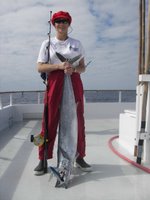AS THE SEASONS CHANGE
Fall 2005 season was spectacular for “catching” giant yellowfin. The fleet scored 2,343 yellowfin tuna over 200 pounds with 10 tuna over 300 pounds before the season ended in June 2006. The previous season (considered the best on record) tallied 457 over 200 pounds. I managed to catch four over 200 pounds before the season ended with the largest a personal best at 245 pounds.
When fall turned to winter, the waters cooled and so did the bite. February’s Braid trip to the Hurricane Bank scored 11 tuna over 200 pounds along with a fair number of wahoo compared to the 78 tuna over 200 caught on the Thanksgiving trip and no wahoo.

Wahoo on the Yummie Flyer
Local waters also cool with the winter weather. While the long-range fleet transitions to 16 to 20-day trips heading to locations requiring 4 or 5 days of boat travel for destinations such as Hurricane Bank, Puerta Vallarta, and Clipperton, local fishing turns to fishing the deeper waters around the Channel Islands for rock fish. Winter finds anglers tending to their reel repairs and cleaning out tackle boxes in between Christmas shopping and holiday festivities.March finds anglers attending the Long Beach Fred Hall Fishing and Tackle show. Landing and sportboat owners, tackle manufacturers, boat companies, tackle shops – (basically anyone in the fishing or boating industry) are represented. The show lasts 5 days and includes seminars to assist the angler become a better fisherman. Some of us work the booths or assist in seminars. I worked the Braid Products booth and assisted Pete Haynes in knot tying seminars.
We all look forward to the show because it’s an opportunity to meet and visit with the boat crews and anglers that you have had the opportunity to fish with previously. It’s like a big family reunion with the opportunity to talk fishing.
After the tackle show, we content ourselves with filling the freezer with good eating rock fish. San Diego boats take anglers down the Baja coast for rock fish while the Channel Islands boats fish Santa Rosa, Santa Cruz or Anacapa Islands. As winter turns to spring, we dream of the white seabass bite to go along with the rock fishing. The Pacific Dawn provided three spring trips this year out of Oxnard to the Channel Islands for L. A. Rod and Reel Club members. The May 8th trip found limits of white seabass by 8:15 a.m. followed by limits of rock fish.
LARRC Charter on the Pacific Dawn
Spring fishing heats up with the arrival of albacore and bluefin. The sportfishing boats complete boat repairs and Coast Guard inspections in anticipation of the summer season. Anglers repack their tackle boxes with albacore and tuna gear while packing away the rock fish tackle for the next year. Fish reports once again become an anglers’ daily obsession.
Summer fishing is noted for “variety” of species, good weather and choices of local or long-range fishing. Local fishing is blessed with calico bass, sand bass, yellowtail, bonito, and barracuda with an occasional tuna or dorado. The long-range fishing fleet pursues wahoo and the larger species of tuna, dorado and yellowtail along the Baja Coast, at Alijos Rocks and Guadalupe Island on trips lasting 5 to 10 days.
As summer turns to fall, the ocean waters warm and the large tuna and wahoo arrive along the Baja coast. Anglers find themselves frenzied to get on a boat to catch their “personal best” before the waters cool and the bite wanes once again transitioning into winter.
Fishing is a passion I feel fortunate to share with some very good fishing buddies. When we are not fishing, we build fishing rods, share fishing stories, exchange information on where to buy tackle and we schedule our next year’s fishing trips. Most long range trips require scheduling and a deposit by November for a trip departing the following year.
I spent several weeks this winter building myself 3 new fishing rods. Fishing rods are surprisingly simple to make but quite time consuming. Splining the blank, glueing the reel seat and grips on, and placement of the guides are first and the most difficult part. Next each guide is secured to the rod by a series of threads wrapped side by side followed by coating them with color preserver. Finally, three or four coats of finish are required with 24 hours drying time in between coats. If a diamond wrap (decorative design) is added, another day’s work is required, however, it is worth the effort.
Rod Wrapping in Winter Months
Sometimes we fill our non-fishing time trying to create a better fish trap. In my case, a better reel and rod cover to protect equipment on the long range boats. I will be testing the covers on my first long trip of the year departing the end of the month.
My Shop and Shop Assistant for Reel Rod Covers
Reel Rod Covers and Order Form
Now its time for me to remove the rock fish tackle out of my box and pack my albacore, bluefin tuna, and yellowtail tackle because spring is turning into summer.











1 Comments:
That was good reading. Have fun on your upcoming trip and good luck on the new rod cover business!
Post a Comment
<< Home